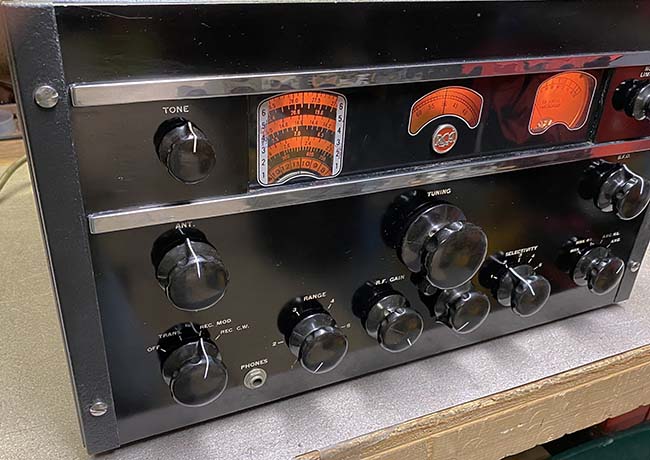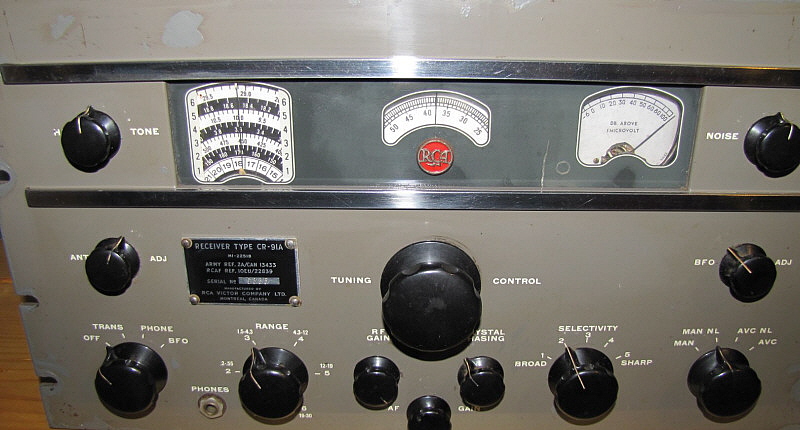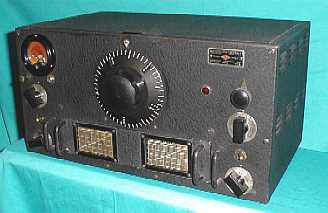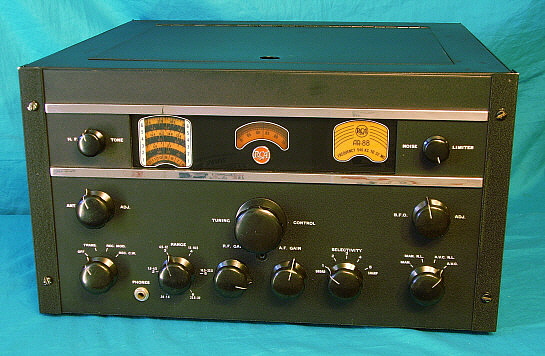|
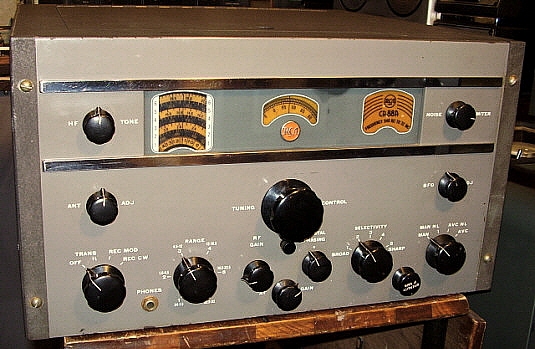 |
|
The
CR-88A version of the AR-88 from around 1947 |
The AR-88 series receivers are examples of 1940s
receiver designs that will perform so well you'll think it was designed
in the 1950s or 1960s. They were actively used by RCA and RMCA up into
the 1970s when most 1940 radio designs had long since retired. Highly
sensitive all the way up to 10 meters with five steps of selectivity to
cope with crowded bands, an effective noise limiter and, of course, that
fabulous audio that reproduces those low bass tones with no distortion.
The AR-88 high frequency sensitivity is renown and was
achieved by using polystyrene coil forms in the higher frequency bands -
and this in a day when most people had never heard of polystyrene
plastic. Full sensitivity is available all the way up to 10 meters.
Hearing stations was really never a problem with the AR-88. Selectivity
is a little problematic because the early AR-88 design assumed that all
you wanted the Crystal Filter for was to narrow the IF passband. It does
that very well but, as many AM ham ops know, a good crystal filter can
also be used to eliminate heterodynes. CW ops know that a good Crystal
Filter can enhance certain audio tones making CW easy to copy through
QRM and QRN. RCA decided to change the AR-88 design after WWII and moved
the Phasing Control to the front panel. If you want to have the
advantage of a Crystal Filter Phasing control easily accessible on the
front panel, you'll have to find the CR-88 version or other late
versions of the receiver.
Dial accuracy is where almost all vintage receivers find
their detractors and the AR-88 is no exception. The tuning dial is
"1940s" accurate but since wide slices of the spectrum are covered in
each band, the resolution of the dial is necessarily vague. The ability
to have 1.0kc readout (or better) on a receiver has been around since
the late 1940s but many of today's hams have never been exposed to how
frequency accuracy was achieved without a Collins-type readout (or, a
modern digital readout.) Before the digital world, every commercial and
military station had heterodyne frequency meters and if it became
necessary to know exactly where the receiver was tuned, these
instruments allowed the operator to set the receiver frequency to better
than 1.0kc accuracy. The extreme scaling of the logging dial (4400
divisions) then allowed the operator to return to that exact frequency
once the relationship of tuned frequency to logging dial reading was known. SSB signals are easy to copy on the AR-88 and you don't need to
do any modifications either. Simply turn off the AVC, increase the AF
gain to near maximum and then reduce the RF gain by about 25%. Tune in
an SSB signal with the receiver in REC CW (BFO on) until the voice
sounds normal but overdriven. Then slowly reduce the RF gain until the
audio clears up. Usually, the RF gain is about 60% or so on most SSB
signals but it depends on signal level and the band in use.
Since a VT-150 tube regulates the +150vdc voltage (which is used for the
LO and BFO plates besides the receiver screen supply) the AR-88 is very stable.
Drift is practically non-existent after about a 10 minute warm-up. You
can listen to the West Coast 40M SSB Swap Net (or your local Amateur HF
SSB Swap Net) without getting up to retune every five minutes. For CW,
the stability makes this mode easy to enjoy when using the AR-88 as the
receiver. >>> |
>>> AM is where the AR-88 really becomes a "great" receiver. Audio
reproduction is wide range in SELECTIVITY BROAD POS 1 and the receiver
will produce undistorted bass notes like no other "communications
receiver" can. Vintage AM ham stations can sound great but the
well-run SW-BC stations
sound incredible on the
AR-88. The same is true for regular AM-BC, only finding good programming
is difficult. If the ham AM signals are weak, better IF gain is available in POS 2.
When QRM becomes a problem, POS 3, POS 4 or, in severe cases, POS 5 can
be used to eliminate the problem. If you have the later versions of the
receiver with the CRYSTAL PHASING on the front panel you can effectively
eliminate SSB QRM with in the MOD (AM) position.
The antenna connections are originally terminal strips but it is easy
to utilize coax as the feed line by connecting the shield to the
ground-A2 terminals and the center conductor to A1. Spade lugs can be
crimped or soldered to the coax shield and center conductor for easy
connection to the terminals. This provides an unbalanced input to the
AR-88 which is the normal output from a standard antenna coupler that
would be used with a typical ham antenna. The type of antenna used with
the receiver will determine its level of performance. A matched resonant
or tuned antenna will give the best results on the lower frequencies and
a gain antenna like a yagi or quad will give excellent results on the
highest frequencies. Using random length, untuned end fed wires will
result in very limited performance potential for the receiver.
Using the correct impedance loud speaker will provide very loud
audio output from the 2.5 ohm Z terminals. The original speaker is hard
to find but any speaker from 3.2 to 4.0 ohms Z will provide very loud
audio output and can reproduce significant bass. Speakers with 8 ohms nominal impedance require that the AF
gain be advanced substantially. Try to use the lower Z speakers for best
audio performance. The AR-88 AF gain control is normally advanced about
20% to 30% for normal listening when in the AVC-controlled AM mode and
driving the correct speaker impedance. You can also utilize the 600 ohm
Z "line" audio output with a matching transformer but I have always
found the 600 ohm Z audio to not be quite as clear sounding as the 2.5
ohms Z output. If you do use the 600 ohm line for the audio output be
sure to install a 4.7 ohm 2W resistor on the 2.5 ohm Z output terminals
for a load.
Using a good quality, 3.2 ohm Z speaker will provide excellent audio
but don't be fooled into thinking that a modern 4 or 8 ohm Z stereo
speaker box will sound really great - they usually don't. The
reason is they aren't very efficient with only 2.5 watts of drive power
available from the AR-88. The old style, fairly stiff suspension, 12" PM
4 ohm Z speaker mounted in a large box with bass reflex port will sound
best. If you can find a large speaker with a 3.2 ohm Z voice coil, the
performance will be even better since you won't have the AF gain quite
so advanced as with the higher Z speakers (for some reason, 12" speakers
with 3.2Z VC seem to be hard to find.) The original MI-8303D speaker is
only an 8" speaker but it is very good for communications-type
audio. The larger speakers with good enclosures will show-off the AR-88
audio best but it does depend on what you're listening to. AM-BC or
SW-BC will offer the best demonstration audio. One last note on
audio,...if you're doing CW you don't want a lot of bass so use to HF
TONE control to enhance the higher tones and that makes CW much easier
to copy.
Then there's the weight issue. There's no doubt that
the AR-88 is a very heavy receiver. In the cabinet, with all of the
shields installed, it will weigh just slightly over 100 pounds. This makes moving
the receiver around a strenuous effort. I find that it's very helpful to
remove the receiver from the cabinet when moving. If the bottom cover is
installed, it should also be dismounted. This will lighten the
load by around 20 to 25 pounds. I've found that AR-88 chassis alone
weighs less than 75 pounds. If the bottom shield is removed, the weight
goes down to about 70 pounds. I don't know where the idea that the "bare"
rack-mount receiver weighs 100 pounds came from - it doesn't. But still, the use of a roll cart is a
tremendous help when moving the receiver from the work bench to another
room - like the ham shack. Finally, remote standby was
never incorporated into the AR-88 series because of its primary function
as a surveillance receiver. There's also quite a bit of negative history
reported if TRANS is used actively for a panel-type of standby switch.
Use of an electronic TR switch also has its own disadvantages unless CW
is your only mode employed. If an actual T-R relay is used and it
provides isolation to the receiver during transmit then the RF gain can
be turned down to avoid audio feedback in the Voice mode. Separate
transmit and receive antennas can also be used but still the receiver
needs to be muted if the mode of transmission is Voice (AM.) The
following section, "An Easy and Reversible Muting Mod for the AR-88
Receivers" provides the details on incorporating a very easy to install
mod that doesn't do any damage and is easy to remove if desired. It
provides a method to remotely mute the AR-88 while in the transmitting
mode. |

